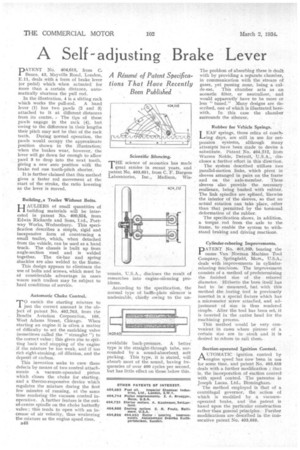A Self-adjusting Brake Lever
Page 62

If you've noticed an error in this article please click here to report it so we can fix it.
PATENT No. 404,018, from C. Bence, 43, Mayville Road, London, E.11, deals with a form of brake lever (or pedal) which when actuated for more than a certain distance, automatically shortens the pull rod.
In the illustration, 4 is a sliding rack which works the pull-rod. A hand lever (1) has two pawls (2 and 3) attached to it at different distances from its centre. ,The tips of these pawls engage in the rack (4), but owing to the difference in their lengths their pitch may not be that of the rack teeth. During normal operation, the pawls would occupy the approximate position shown in the illustration; when the brakes wear, however, the lever will go down far enough to allow pawl 3 to drop into the next tooth, giving a new zero position with the brake rod one tooth-pitch shorter.
• It is further claimed that this method gives a faster rod movement at the start of the stroke, the ratio lowering as the lever is moved.
Building,a Trailer Without Bolts.
H.1 AULIERS of small quantities of building materials will be interested in patent No. 400,834, from Edwin Richards and Sons, Ltd., Portway Works, Wednesbury. This specification describes a simple, rigid and inexpensive form of construcing a small trailer, which, when detached from the vehicle, can be used as a hand truck. The chassis is built up from angle-section steel and is welded together. The tie-bar and spring shackles are also welded to the frame.
This design appears to eliminate the use of bolts and screws, which must be of considerable advantage in cases wnere such trallerg may he subject to hard conditions of service.
Automatic Choke Control.
TO enrich the starting mixture to just the correct amount is the object of patent No. 402,763, from the Bendix Aviation Corporation, 105, West Adams Street, Chicago. When starting an engine it is often a matter of difficulty to set the enriching valve (sometimes called the " strangler ") to the correct value ; this gives rise to spitting back and stopping of the engine if the mixture be too weak, and if too rich eight-stroking, oil dilution, and the deposit of carbon.
This invention seeks to cure these defects by means of two control attachments a vacuum-operated piston which closes the choke for starting, and a thermo-responsive device which regulates the mixture during the first few minutes of running, at the same time rendering the vacuum control inoperative. A further feature is the outof-centre spindle on the choke butterfly valve ; this tends to -open with an increase of air velocity, thus weakening the mixture as the engine speed rises.
Scientific Silencing.
THE science of acoustics has made great strides in recent years, and patent No. 403,651, from C. F. Burgess Laboratories, Inc., Madison, Wis
cousin, U.S.A., discloses the result of researches into engine-silencing problems.
According to the specification, the normal type of baffle-plate silencer is undesirable, chiefly owing to the un avoidable back-pressure. A better type is the straight-through tube, surrounded by a sound-absorbent soft packing. This type, it is stated, will absorb most of the sound, having frequencies of over 400 cycles per second, but has little effect on those below this. The problem of absorbing these is dealt with by providing a separate chamber, in communication with the stream of gases, yet passing none, being a culde-sac. This chamber acts as an acoustic filter, or neutralizer, and would apparently have to be more or less "tuned." Many designs are described, one of which is illustrated herewith. Inthis case the chamber surrounds the silencer.
Rubber for Vehicle Springs.
LEAF springs, those relics of coaching days, are still in use for suspension systems, although many attempts have been made to devise a substitute. Patent No. 404,212, from Warren Noble, Detroit, U.S.A., discloses a further effort in this directim
The system described utilizes two parallel-motion links, which pivot in sleeves arranged in pairs on the frame and on the axle-member, These sleeves also provide the necessary resilience, being bushed with rubber. The link spindles are splined, likewise the interior of the sleeves, so that no actual rotation can take place, other than that permitted by the torsional deformation of the rubber.
The specification shows, in addition, a torque rod from the axle to the frame, to enable the system to withstand braking and driving reactions.
Cylinder-reboring Improvements.
PATENT No. 401,169, bearing the name Van Norman Machine Tool Company, Springfield, Mass., U.S.A., deals with improvements in cylinderreboring machines. The improvement consists of a method of predetermining the finished size of the rebored diameter. Hitherto the bore itself has had to be measured, but with this method the boring tool is previously inserted in a special fixture which has a micrometer screw attached, and adjustment of size is thus rendered simple. After the tool has been set, it is inserted in the cutter head for the machining process.
This method would be very convenient in cases where pistons of a certain size are in stock and it is desired to rebore to &aft them.
Suction-operated Ignition Control.
AUTOMATIC ignition control by engine speed has now been in uste for some time, and patent No. 403,658 deals with a further modification ; that is, the incorporation of suction control with speed control. The patentee is Joseph Lucas, Ltd., Birmingham.
The method employed is that of a centrifugal governor, the action of which is modified by a Vacuumoperated brake, and the patent is based upon the particular construction rather than general principles. Further modifications are described in the consecutive patent No. 403,659.




























































































